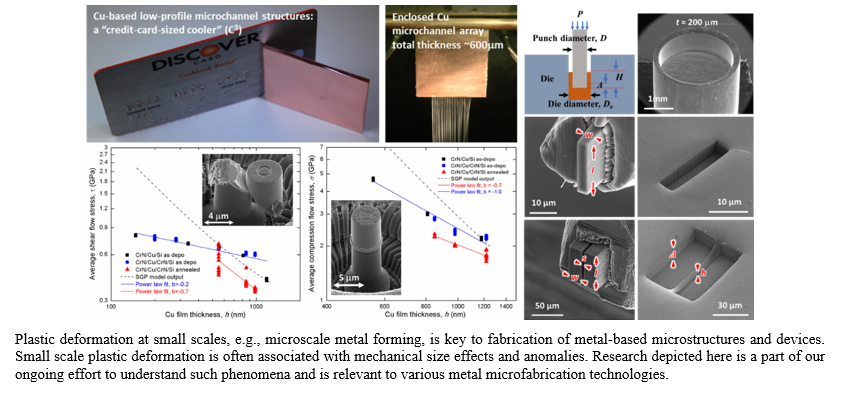Video Article Open Access
Probing Mechanical Size Effects and Anomalies in Small Scale Plastic Deformation
W.J. Meng1,*, Bin Zhang1, Andrew C. Meng2, Kim L. Nielsen3
1Louisiana State University, Baton Rouge, Louisiana, 70803, USA
2University of Pennsylvania, Philadelphia, Pennsylvania, 19104, USA
3Technical University of Denmark, Lyngby, 2800 Kgs, Denmark
Vid. Proc. Adv. Mater., Volume 3, Article ID 2208318 (2022)
DOI: 10.5185/vpoam.2022.08318
Publication Date (Web): 10 Mar 2023
Copyright © IAAM
Graphical Abstract

Abstract
With the continuing trend of product miniaturization, an unabating need exists for metal-based micro parts, many of which have already been widely used in the automotive industry, consumer electronics industry, and other industrial sectors. Metallic micro parts can be produced through different manufacturing processes. Contrasting subtractive fabrication techniques such as micro mechanical machining, electrical discharge machining, and laser machining, micro metal forming encompasses a distinct class of fabrication techniques that depend on plastic deformation to achieve the fabrication goal. Known for advantages of low-cost, high-throughput, and good mechanical properties of the formed parts, metal forming at the macroscale is a mature technology and a mainstay of traditional manufacturing. Micro forming produces parts with at least two characteristic dimensions at the sub-mm scale. While metal forming at the macroscale and forming at the meso/micro/nano scales are both based on plastic deformation, meso/micro/nano scale metal forming operations offers a class of problems in which the characteristic length scale associated with the geometry of plastic deformation is either sufficiently small in an intrinsic sense or sufficiently small to approach the average grain size of the material being formed. In either case, the material being deformed exhibits mechanical size effects and mechanical anomalies, i.e., mechanical responses that depend explicitly on the deformation length scale and mechanical behaviors that deviate from those expected from continuum mechanics. The existence of various mechanical size effects impedes a straight-forward transfer of knowledge gained in macroscale metal forming to forming at characteristic dimensions from hundreds of microns and beyond to tens of microns and below. This talk presents an overview of our efforts to probe and understand mechanical size effects and mechanical anomalies associated with small scale plastic deformation. Understanding such mechanical size effects is a technological prerequisite for effective forming process design and presents an opportunity to deepen the fundamental understanding of plastic response of materials at small length scales. This talk will summarize the recent progress we have made and suggest directions for future investigations.
Keywords
Micro metal forming; micro molding; microscale mechanical testing; multiscale structural characterization.
Acknowledgement
Partial project support from the U.S. National Science Foundation, under award numbers #OIA-1541079 and #OIA-1946231, and from the Louisiana Board of Regents is gratefully acknowledged.
References
- Y. Mu, J.W. Hutchinson, W.J. Meng, Extreme Mech. Lett., 2014, 1, 62.
- B. Zhang, W.J. Meng, ASME J. Micro Nano Manufacturing, 2020, 8, 010910.
- B. Zhang, M.S. Dodaran, S. Shao, J. Choi, S. Park, W.J. Meng, Int. J. Mech. Sci., 2020, 172, 105406.
- B. Zhang, W.J. Meng, Materials and Design, 2021, 206, 109807.
- B. Zhang, A.C. Meng, W.J. Meng, Int. J. Machine Tools and Manufacture, 2021, 169, 103795.
Biography
Wen Jin Meng received his B.S. degree in Physics in 1982 and his Ph.D. degree in Applied Physics in 1988, both from California Institute of Technology. He served as a post-doctoral fellow in the Materials Science Division of Argonne National Laboratory from 1988 to 1989 and a staff research scientist in the General Motors/Delphi Automotive Systems R&D Center from 1989 to 1999. Since 1999, he has been a faculty member with Louisiana State University, where he is currently the Smiley and Bernice Romero Raborn Endowed Chair and Professor of Mechanical Engineering. His research spans topics concerning solid-state phase transformations, vapor phase growth of ceramic and metal thin films, nanostructured ceramic coatings and surface engineering, mechanical testing at small length scales, and micro/nano scale fabrication and assembly of metal-based micro/nano structures and devices. He was elected to the National Academy of Inventors in 2014 for his innovations on micron scale replication technologies. From 2015 to 2021, he served as the scientific lead for a U.S. National Science Foundation program awarded to the state of Louisiana to establish the Consortium for Innovation in Manufacturing and Materials, with programmatic focus on advanced manufacturing technologies and associated materials research.
Video Proceedings of Advanced Materials

Upcoming Congress



